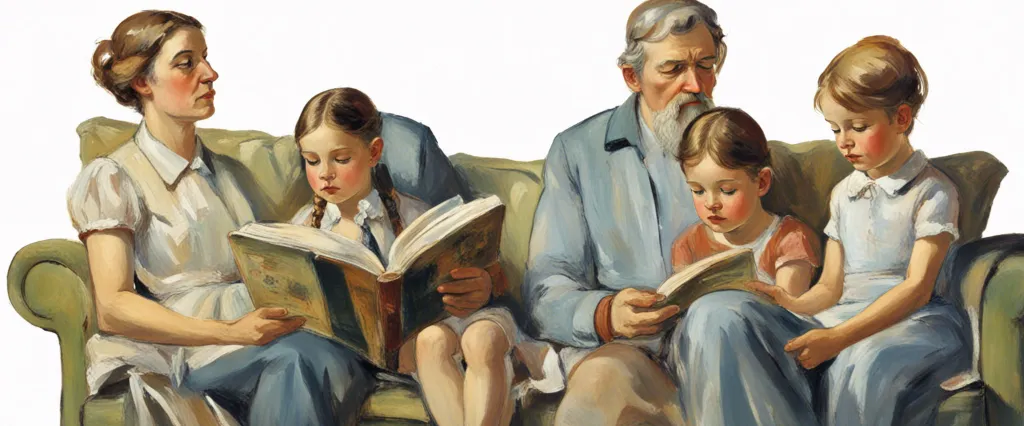Between Parent and Child by Haim G. Ginott is a classic parenting guide that provides invaluable insights and practical strategies for fostering healthy communication and developing positive relationships with children.
Ginott, a child psychologist, argues that the key to effective parenting lies in treating children with empathy, respect, and understanding. He emphasizes the importance of recognizing and validating children’s feelings, as well as providing them with a safe and supportive environment to express themselves.
The book teaches parents how to engage in active listening, to focus on the emotions behind their children’s words, and to respond thoughtfully without dismissing or invalidating their feelings. Ginott advises against harsh discipline techniques or belittling children, and instead suggests using non-violent communication techniques that promote trust, empathy, and cooperation.
Throughout the book, Ginott provides various examples and practical advice on how to address common parenting challenges such as sibling rivalry, power struggles, discipline issues, and conflicts. He also offers guidance on how to communicate effectively during difficult situations such as divorce or the loss of a loved one.
Ultimately, Between Parent and Child encourages parents to build strong and open relationships with their children, creating an environment of love, respect, and understanding that fosters healthy emotional development and lays the foundation for positive connections later in life.
“The Coddling of the American Mind” by Greg Lukianoff and Jonathan Haidt explores the negative consequences of overprotective parenting and a culture of fragility on college campuses and society at large. Lukianoff, who is the president and CEO of the Foundation for Individual Rights in Education (FIRE), and social psychologist Haidt argue that these factors have led to an increased intolerance of opposing viewpoints, a decline in intellectual freedom, and an erosion of mental resilience among American young adults.
The book introduces three overarching “untruths” that have become prominent in American society and affect the minds of young people. The first is the untruth of fragility, which suggests that people are emotionally vulnerable and in need of protection from potentially harmful ideas or speech. The second is the untruth of emotional reasoning, which encourages individuals to prioritize their feelings over objective facts and evidence. Lastly, the untruth of us vs. them promotes the idea that the world can be divided into good and evil, leading to an “either you’re with us or against us” mentality.
Lukianoff and Haidt delve into various phenomena, such as the rise of trigger warnings, safe spaces, and the concept of microaggressions, which they argue contribute to a culture of coddling. They argue that while intentions behind these measures may be well-meaning, they ultimately hinder students’ resilience, critical thinking skills, and ability to engage with diverse ideas.
The authors also analyze the effects of social media and the constant exposure to online threats, which they argue contribute to the rising levels of anxiety and depression among the younger generation. They suggest that teaching students cognitive behavioral therapy techniques and promoting a culture of free speech and intellectual diversity can help counter these negative trends.
“The Coddling of the American Mind” provides insights into the challenges faced by today’s youth, the consequences of excessive protection, and offers suggestions to foster a healthier intellectual environment that promotes open dialogue, resilience, and intellectual growth.
Comparison between Two Books
The books “Between Parent and Child” by Haim G. Ginott and “The Coddling of the American Mind” by Greg Lukianoff may revolve around different aspects of parenting and education, but they share some similarities when it comes to their discussions about teenagers.
1. Importance of open communication: Both books emphasize the significance of cultivating open and honest communication with teenagers. They highlight the need for parents and educators to create safe spaces where teenagers feel comfortable expressing their thoughts, concerns, and emotions. This emphasis on open communication aims to foster healthy relationships and understanding between adults and teenagers.
2. Navigating emotional challenges: Both books recognize that teenagers often face emotional challenges and may struggle with understanding and regulating their emotions. The authors discuss the importance of validating teenagers’ feelings and providing them with the necessary emotional support. Moreover, they emphasize the role of adults in teaching teenagers effective strategies for managing and expressing their emotions in a healthy way.
3. The impact of society on teenagers: Both books explore how societal factors can have a significant influence on teenagers’ psychological well-being. “Between Parent and Child” acknowledges the impact of societal pressures on teenagers, such as academic stress and social comparison. Similarly, “The Coddling of the American Mind” delves into how certain cultural tendencies, such as overprotection or a fear of failure, can impact teenagers’ resilience and ability to cope with challenges.
4. Encouraging autonomy and responsibility: The books touch upon the importance of allowing teenagers to develop autonomy and take responsibility for their actions. “Between Parent and Child” emphasizes the significance of giving teenagers opportunities to make decisions and express their own opinions, fostering a sense of independence. Similarly, “The Coddling of the American Mind” discusses the benefits of allowing teenagers to face and learn from their own mistakes, promoting resilience and personal growth.
5. Striving for balance: Both books suggest that finding a balance between being supportive and setting boundaries is crucial when it comes to parenting and educating teenagers. They advocate for adults to be involved in teenagers’ lives while also providing enough room for them to develop their own identity and navigate the challenges that come with adolescence.
Overall, both “Between Parent and Child” and “The Coddling of the American Mind” shed light on the importance of open communication, understanding, and fostering a balanced approach when interacting with teenagers. They recognize the unique challenges faced by adolescents and provide insights for parents, educators, and society as a whole in supporting their well-being and development.
While “Between Parent and Child” by Haim G. Ginott primarily focuses on parent-child relationships and communication, “The Coddling of the American Mind” by Greg Lukianoff and Jonathan Haidt discusses the challenges faced by teenagers in America today. Both books provide valuable insights into the dynamics between parents and teenagers, but they differ in their approach and perspectives concerning the teenage experience.
Divergence in Perspectives:
1. Approach to Parenting: “Between Parent and Child” emphasizes the importance of effective and empathetic communication between parents and their children. Ginott encourages parents to actively listen, show understanding, and avoid criticism or judgment. In contrast, “The Coddling of the American Mind” argues that overprotective parenting styles can hinder teenagers’ development, recommending a more hands-off approach that allows teenagers to experience discomfort and learn from failure.
2. Pressure and Anxiety: Ginott discusses the pressures faced by teenagers, highlighting the importance of acknowledging their anxieties and concerns. He emphasizes the need for parents to provide emotional support and a safe space for teenagers to express their feelings. On the other hand, “The Coddling of the American Mind” delves into the rise of exaggerated fears and anxieties among teenagers. It suggests that this may be due to overprotection and a lack of exposure to challenges, leading to a generation that is more prone to emotional fragility.
3. Dealing with Conflict: Ginott emphasizes conflict resolution techniques, focusing on maintaining respectful and positive relationships. He provides specific communication tools for parents to use, such as the “I-Message” technique, which encourages open dialogue. Conversely, “The Coddling of the American Mind” explores how the avoidance of conflict and the promotion of emotional safety can hinder teenagers in developing resilience and the ability to handle disagreement or discomfort.
4. Inclusivity and Microaggressions: “The Coddling of the American Mind” delves into the concept of microaggressions, suggesting that an overemphasis on protecting individuals from perceived slights or insults can lead to a hypersensitive generation. This perspective urges teenagers to develop resilience and a healthier approach to handling minor conflicts. In contrast, “Between Parent and Child” does not explicitly address these concepts but focuses more on building healthy and open relationships within the family.
In conclusion, while “Between Parent and Child” emphasizes effective communication between parents and teenagers, “The Coddling of the American Mind” offers insights into the challenges faced by teenagers in today’s society. The former highlights the importance of creating a supportive environment, while the latter suggests that teenagers benefit from facing discomfort and resolving conflicts independently. Both books provide valuable guidance, but with slightly differing approaches to understanding and addressing the needs of teenagers.




